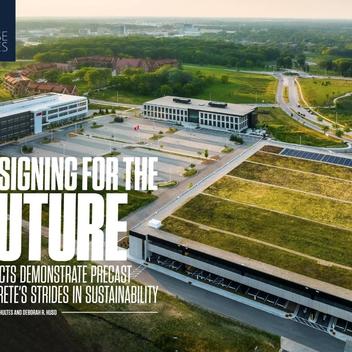This Design Guide Series episode delves into the environmental impact of concrete and how Environmental Product Declarations are supporting smarter design decisions for greener buildings.
Topics covered in this video include:
- Understanding an Environmental Product Declaration (EPD)
- How Wells uses EPDs
- The role of prefabrication in sustainable design
Concrete is the most widely used man-made material on Earth. But what’s its environmental impact? And how can you make smarter, more sustainable design choices with it?
What is an EPD?
An environmental product declaration, or EPD, is a standardized document that transparently reports the environmental impact of a product from cradle to grave. For our industry, EPD’s represent the environmental impact from cradle to gate, where cradle represents the extraction of raw materials and gate represents the point where the product leaves our facility. You can think of it like a nutrition label for materials, labels that inform you of the global warming potential, or GWP of a product or project. Wells offers third-party verified EPDs for its building solutions, helping design teams make informed, sustainable choices.
How does an EPD use PCRs and LCAs?
These declarations are powered by a behind-the-scenes Life Cycle Assessment, or LCA—which analyzes environmental impacts from raw material extraction, material delivery, all the way through the manufacturing process – cradle to gate. To ensure consistency, all EPDs follow a product category rule, or PCR, and are reviewed and verified by an independent third party. Our PCR was developed for precast concrete in coordination with the National Center for Sustainability Standards.
What does an EPD include?
A typical EPD includes 5 areas: general information, LCA methodology, product details, impact results, and data sources. These give design professionals insight into the impact of their material selections. Wells works with our clients and design partners to provide a project EPDs that reflect results from the exact design and building process—offering more precise, localized data.
Applying EPDs to your project.
But remember—EPDs are often not apples-to-apples. Differences in rules, data sets, or assumptions can affect results. Comparing EPDs requires a careful look at functional equivalency and methodology.
By working with Wells’ preconstruction team early in the design process, they can help navigate solutions to meet your sustainability goals. A majority of a building’s environmental impact is based on the operational performance of the building, including heating/cooling, routine maintenance and repair. Selecting materials that perform and last is an important consideration.
The power of prefabrication in sustainable design.
Prefabrication plays a powerful role in sustainable design. Prefabricated building systems—like those made by Wells—are durable, weather-resistant, and built to last, reducing long-term maintenance and material use.
Because they’re made in controlled manufacturing environments, our building solutions minimize waste, improve material efficiency, and maintain consistent quality. Wells’ continues to assess and optimize our facilities to deliver high-performing solutions with a lower environmental impact. With a commitment to transparency and long-term performance, Wells empowers partners to build better—using building solutions that support a more sustainable future.
Additional Sustainability Resources:
Related insights:



